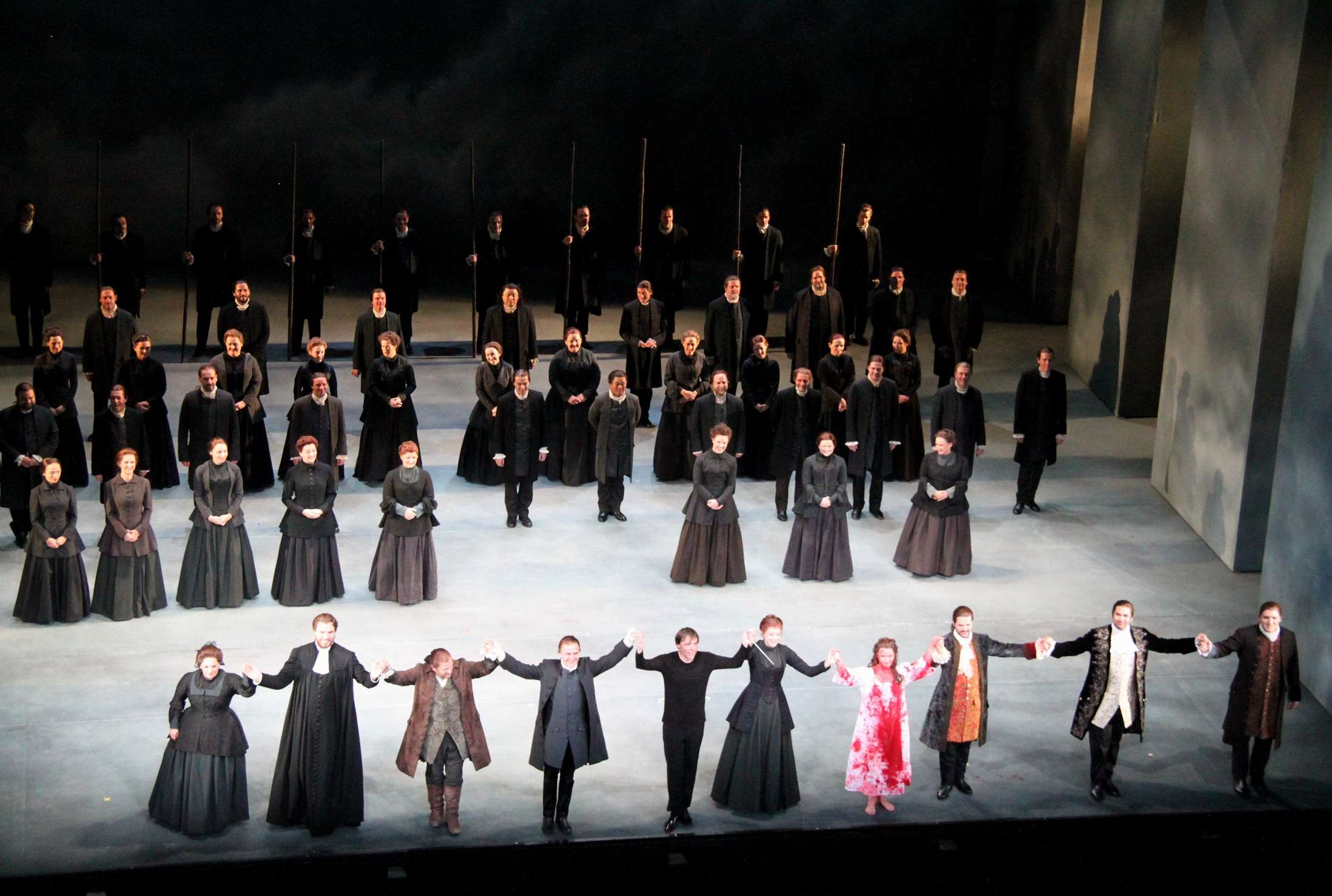|
Back
Psychodrama Drenched in Blood Melbourne
State Theater
11/19/2012 - & November 24, 27, 30, December 5, 8, 12*, 15, 2012
Gaetano Donizetti: Lucia di Lammermoor
Emma Matthews (Lucia di Lammermoor), Aldo di Toro (Edgardo), Giorgio Caoduro (Enrico), Jonathan Abernethy (Normanno), David Parkin (Raimondo), Teresa La Rocca (Alisa), Stephen Smith (Arturo)
Opera Australia Chorus, Michael Black (Chorus Master), Orchestra Victoria, Guillaume Tourniaire (Conductor)
John Doyle (Director), Liz Ascroft (sets, costumes, lights)

(© GP)
This is not a sumptuous production. It is sparse, stark and confronting. Gone are the glowering castle walls, the sweeping staircase, the kilts and tartans of the old Opera Australia production which hailed from the Joan Sutherland era and earlier. This is a new envisaging of the drama which focuses all the action and attention on the plight of the heroine and the bullying paternalism of the men who surround her.
The production is a joint venture between Opera Australia, the Houston Grand Opera and the Teatro La Fenice, Venice and this season in Melbourne represents the Australian premiere.
The designer has set the piece on an open stage, framed by box-like screens covered in cloudscapes rendered in muted tones of blues and greys. A front wall of the ‘box’ raises and lowers to force the action to the front or to incorporate a cavernous space at the rear. The spaces dwarf the performers and the overwhelming mood created by the design is threat, gloom and oppression. Lucia is brow-beaten into submission to her brother’s ambitions for renewal of the family’s fortunes. She is shepherded by lines of male attendants bearing huge staves or avenues of attendants and clansmen, ensuring that she treads the lines of compliance and submission to the collective will of the Lammermoors. From the start of the opera, the director has ensured awareness of the determination, authority and power of the men. They drive all elements of the action, often progressing in phalanx to the front of the stage to glare at the audience, enforcing their will, permitting no dissent.
Lucia’s pleas for understanding, her fragile attempts at defiance and her crushed idealism are all subservient to the strength of the clan. The designer has given us very little colour to visually differentiate the roles of the other characters including the chorus. Presented in black and greys, the costuming provides reminder of the expectations of the family Lucia’s inability to free herself from ‘duty’.
Orchestra Victoria under French conductor Guillaume Tourniaire gave a creditable rendition of the score. Broodingly dark; blaringly determined from the horns and brass and at times militaristic, marching the drama towards its climax. Some of the tempi were questionable and more than once, the performers on stage struggled to maintain the relationship with those in the pit. Nevertheless, the instrumentalists provided a crisp and rich accompaniment to the on-stage action.
The Opera Australia Chorus while modest in numbers took detailed character roles in the production. They directed attention towards much of the soloists’ action and augmented the stark setting sometimes suggesting the walls of the deteriorating house, sometimes the path into the forest or the route for the bridal procession. Musically, they were dark in tone and as threatening as their austere costumes. Frequently, they moved in tempo as a procession, suggesting the inevitable descent into pain and suffering for the title character.
The singing of the men was overshadowed by that of Emma Matthews as Lucia. Both Australian tenor Aldo di Toro as Edgardo and Italian Baritone Giorgio Caoduro as Lucia’s brother Enrico seemed under-voiced at times. This became evident in the partnerships with Lucia as Emma Matthews was clearly holding back to compensate. In the later solos for the two male leads, performances were more assured and by the final scene, Aldo di Toro gave a very creditable rendition of the double aria and recitative which end the opera. He captured the sentimentality and pathos of Edgardo’s despair beautifully and to thunderous reception.
Almost casting the other performances into the shade, Emma Matthews gave us a Lucia who transitioned from girlish pleasure at her secret romance to screaming madness in her great scene from Act Three. The first aria from Act One was light and vibrant. She used her masterly control of the ornamentation in a restrained and under-played manner to project confidence and innocence.
It is impossible however to look further than the ‘Mad Scene’ from Act Three for a clearer picture of an artist at the peak of her powers. The staging forced our eyes to Lucia alone but it was the extent and variety of Emma Matthews’ vocal portrayal which captured total attention. The vivid ornamentation of the vocal line became screams of pain and anguish as she variously moved into and out of sanity; cowering under the furniture or spread-eagled on the table top reliving the forced consummation of her marriage to Arturo. Not content to have her blood-spattered and stained, the director has Lucia reach into a silver bucket from the wedding banquet only to find more blood therein and to paint herself from head to foot. The more intense the coloratura, trills and runs, the more frantically she cupped blood over herself in a riveting and shocking portrayal of despair and anguish.
This production of Lucia di Lammermoor is as far from traditional as could be imagined. The emphasis throughout is on the psychological drama and an inevitable progress towards despair and hopelessness. A thought provoking and compelling production.
ConcertoNet is on Facebook
Twitter: @concertonet
Gregory Pritchard
|